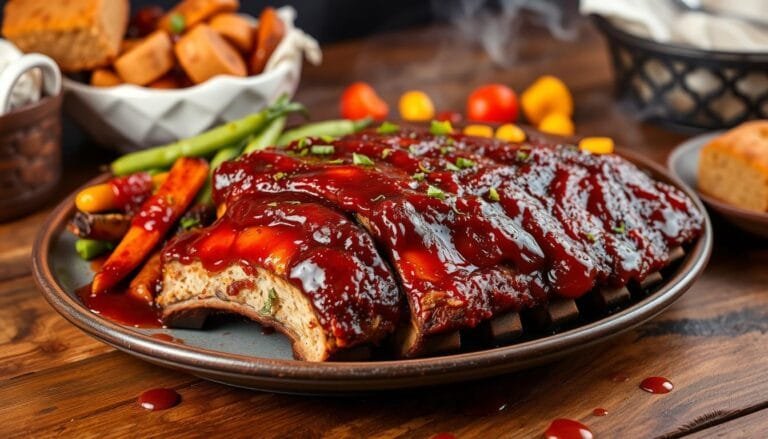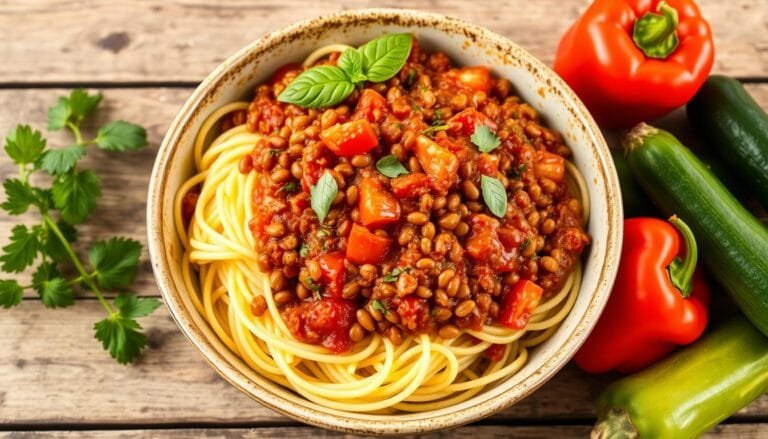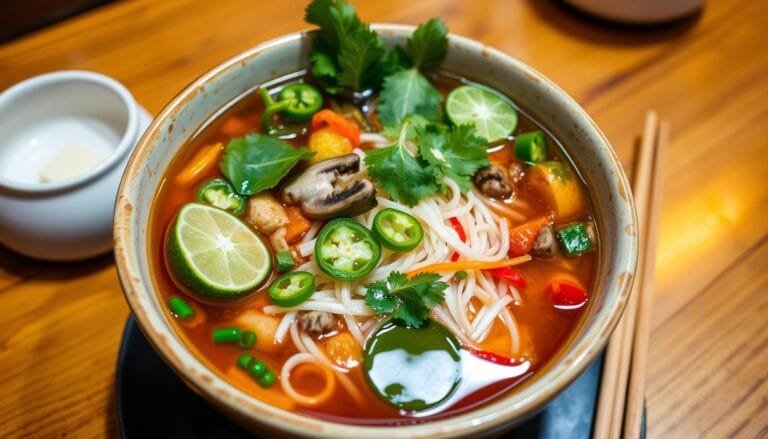I love Indian food, and samosas are a favorite. But as a vegan, I wanted a plant-based version. So, I’m excited to share my recipe for vegan samosas with spiced potatoes, inspired by India’s street food.
Vegan samosas are a tasty twist on the classic. They have a flaky filo pastry shell and a filling of potatoes and peas. Each bite is full of flavor, taking you to India’s busy streets. You can fry, bake, or air fry them for crispy, golden samosas.
In this guide, I’ll show you how to make vegan samosas from scratch. I’ll share tips for the best results. Get ready to wow your friends and family with this authentic Indian appetizer that’s also vegan!
Introduction to Traditional Indian Samosas
Samosas are a favorite snack from India that’s loved worldwide. They come from the Mughlai cuisine of North India. Introduced by traders and invaders from the Middle East, samosas have a long history.
History of Samosas in Indian Cuisine
The samosa’s story begins in the 10th century, in Persian writings. As it spread, the samosa’s recipe and shape changed. It became a key part of Indian Mughlai cuisine. In North India, samosas became a favorite Indian street food.
Why Choose Vegan Samosas
Vegan samosas are a tasty, meat-free option. They use spiced potatoes and peas for filling. This makes them great for vegans and vegetarians, keeping the samosa’s classic taste.
What Makes These Samosas Special
Samosas stand out with their unique shape and crispy outside. The flaky pastry holds a flavorful, spiced filling. This mix of textures and tastes makes samosas a favorite snack globally.
“Samosas are a beloved and iconic part of Indian cuisine, with a rich history that spans continents and cultures.”
Essential Ingredients for Perfect Vegan Samosas
To make delicious vegan samosas, you need the right ingredients. For the pastry, I use unbleached all-purpose flour and vegan butter. This mix gives the samosas a crispy texture. I also add ajwain seeds, salt, and vegetable oil to the dough for that authentic Indian taste.
The filling is what makes these samosas special. I boil and peel potatoes and mix them with spices. These include coriander, cumin, garam masala, and a bit of amchur powder. Fresh ginger and green chilies add a zesty flavor. Frozen green peas add color and texture.
| Ingredient | Quantity |
|---|---|
| Unbleached All-Purpose Flour | 2 cups |
| Vegan Butter | 4 tablespoons |
| Ajwain Seeds | 1 teaspoon |
| Salt | 1 teaspoon |
| Vegetable Oil | 1 tablespoon |
| Boiled, Peeled Potatoes | 1 ½ pounds |
| Frozen Green Peas | 1 cup |
| Ginger | 1-inch knob |
| Green Chilies | 2-3 |
| Coriander Powder | 1 teaspoon |
| Cumin Powder | 1 teaspoon |
| Garam Masala | 1 teaspoon |
| Amchur (Dry Mango Powder) | 1 teaspoon |
| Turmeric | 1/2 teaspoon |
With these ingredients, you can make delicious vegan samosas at home. They’ll taste just like the ones from your favorite Indian restaurant.
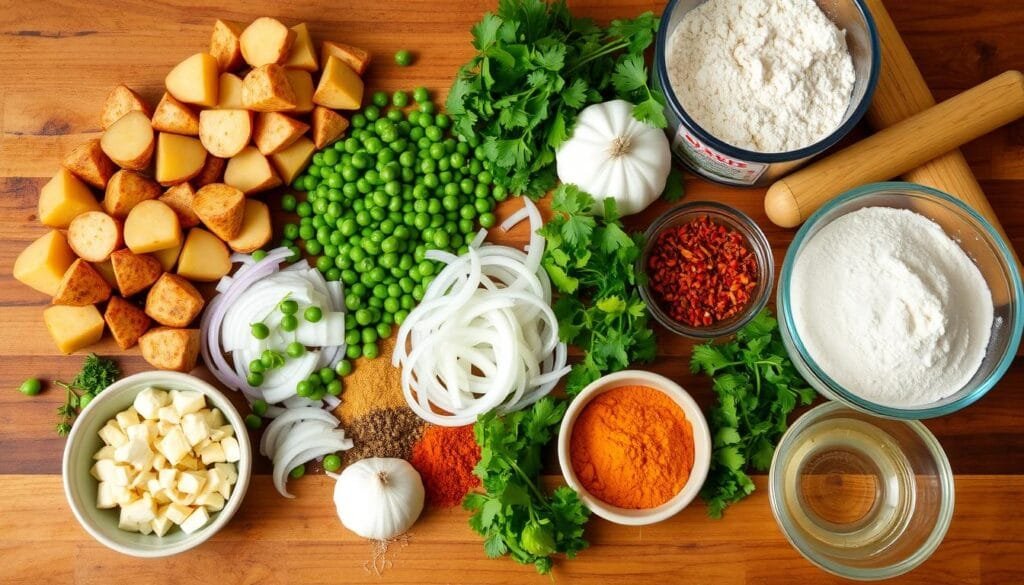
Making the Perfect Flaky Samosa Dough
Making the perfect samosa dough is key to delicious, crispy pastries. The secret is in how you handle the dough. Let’s explore the secrets to making the best samosa dough.
Tips for Achieving Crispy Texture
To get a flaky, crispy dough, the fat to flour ratio is important. Mix in chilled vegan butter or oil until it looks like coarse breadcrumbs. This makes your samosa dough just right. Don’t overwork the dough, or it will be tough and chewy.
Common Dough Mistakes to Avoid
- Overmixing the dough, which can result in a tough, dense texture
- Using warm or room-temperature water, which can cause the flaky pastry to become tough and difficult to work with
- Skimping on the resting time, as the dough needs at least 30 minutes to relax and develop flavor
Proper Kneading Techniques
Kneading the vegan pastry techniques dough is vital for the right texture. Fold and press the dough gently, without overdoing it. You want a smooth, elastic dough that’s stiff but easy to shape. Letting the dough rest before rolling and shaping is key for the best results.
“The secret to a flaky, crisp samosa dough lies in the perfect balance of fat and flour.”
Mastering samosa dough preparation will help you make authentic, delicious vegan samosas. Remember these tips, and let’s start making!
Vegan Samosas with Spiced Potatoes
Get ready for a flavorful journey with these vegan samosas filled with spiced potatoes. They’re packed with aromatic Indian spices, making them a treat for your taste buds.
The secret to the filling is in the mix of boiled potatoes, green peas, and spices. I start by sautéing green chilies and ginger. Then, I add spices like cumin, coriander, and turmeric for that Indian flavor.
To get the right texture, I mash the potatoes but keep some chunks. It’s important to let the filling cool before filling the samosas. This keeps the dough crisp and flaky.
| Ingredient | Quantity |
|---|---|
| Potatoes, boiled and mashed | 500g (17.6 oz) |
| Green peas | 100g (3.5 oz) |
| Green chilies, diced | 2 tablespoons |
| Ginger, minced | 1 tablespoon |
| Cumin powder | 1 teaspoon |
| Coriander powder | 1 teaspoon |
| Turmeric powder | 1/2 teaspoon |
| Salt | to taste |
Now, it’s time to fill the vegan potato filling, Indian spices, and samosa stuffing into the samosa shells. Prepare to enjoy the crispy pastry and the aromatic filling in every bite!

Step-by-Step Samosa Folding Guide
Learning to fold samosas is key to making those tasty, triangle-shaped pastries. They’re a big part of Indian cuisine. Let’s go through the steps to get the perfect samosa fold every time.
Traditional Triangle Folding Method
Begin by rolling out the dough into oval shapes. Cut each oval in half to make semicircles. Now, it’s time to shape the samosa.
Hold the semicircle in your palm and bring the corners together. This forms a cone. Seal the seam with water to make it tight and leak-free.
Fill the cone with spiced potato mixture, leaving a small opening at the top. Press the top seam together, making a slight fold in the center. This classic method makes the triangle-shaped samosa.
Sealing Techniques for Leak-Proof Samosas
- Use a small amount of water to seal the seams, ensuring a tight, secure closure.
- Gently press and crimp the edges to further reinforce the seal and prevent any leakage during cooking.
- For extra assurance, you can lightly brush the sealed edges with a beaten egg or milk to create a golden, shiny finish.
Proper sealing is key to keep the filling inside during frying or baking. Take your time and focus on the seams for perfect, leak-proof samosas.
“The true art of samosa making lies in the intricacy of folding and sealing. With practice, you’ll soon make samosas that look like they came from a pro.”
Cooking Methods: Frying vs Baking vs Air Frying
Preparing vegan samosas offers several cooking options. Deep-frying in vegetable oil makes them golden and crispy. It’s important to keep the oil at 325°F (165°C) for the best crunch.
Baking is a healthier choice. It uses a preheated oven at 350°F (180°C) for 25 minutes. This method gives a flaky crust without too much oil. Make sure to oil or spray the samosas lightly before baking.
Air frying is a convenient, mess-free option. It combines the crispiness of deep-frying with baking’s health benefits. Cook the samosas in an air fryer at 350°F (180°C) for 10-12 minutes. Lightly spray them with oil as needed for a crispy exterior without oil.
| Cooking Method | Temperature | Time | Characteristics |
|---|---|---|---|
| Deep-Fried | 325°F (165°C) | 15-18 minutes | Crispy, golden-brown exterior |
| Baked | 350°F (180°C) | 25-30 minutes | Flaky, crisp crust |
| Air Fried | 350°F (180°C) | 10-12 minutes | Crisp exterior, healthier |
Delicious vegan samosas come from the right mix of flavors and textures. Try different cooking methods to find what you like best.
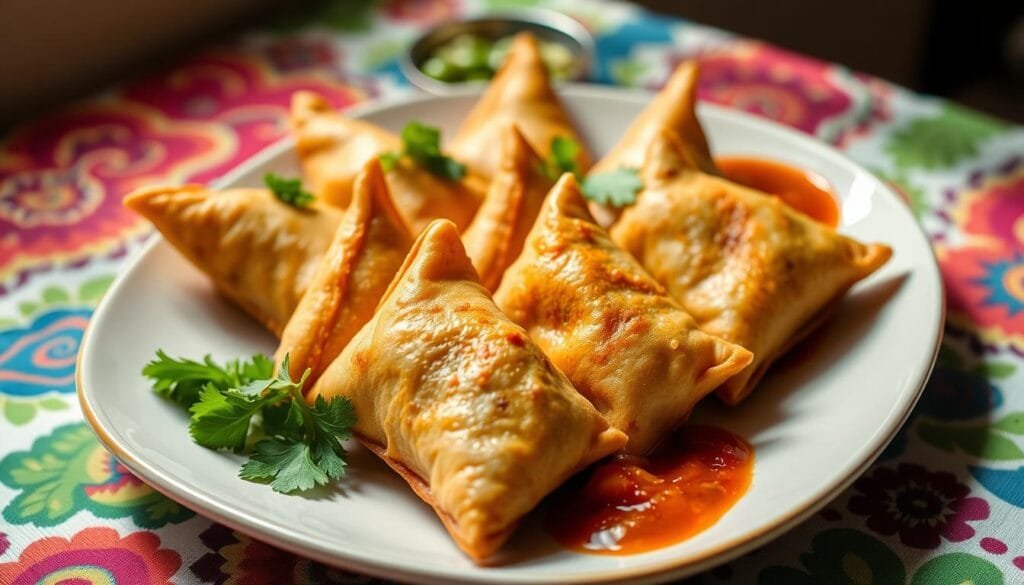
Essential Tips for Crispy Golden Results
To get perfect crispy and golden samosas, pay close attention to a few key things. Keeping the oil temperature right is very important. Try to keep it around 325°F (165°C) for even cooking and crispiness. Don’t let the oil get too hot, as it can burn the samosas.
Also, don’t overcrowd the pan when frying. This can lower the oil temperature and make the samosas soggy.
Oil Temperature Control
Getting the right oil temperature is key for crispy samosas. Here are some tips to help you:
- Use a deep-fry or candy thermometer to monitor the oil temperature closely.
- Adjust the heat as needed to maintain the ideal 325°F (165°C) range.
- Fry the samosas in batches to prevent the oil temperature from dropping too low.
- Allow the oil to return to the proper temperature between batches.
Storage and Reheating Guidelines
Storing and reheating your samosas right can also help keep them crispy. Here’s what you need to know:
- For cooked samosas, keep them in an airtight container in the refrigerator for up to 3-4 days.
- To freeze uncooked samosas, place them on a baking sheet and freeze until solid, then transfer to an airtight container or freezer bag for up to 2-3 months.
- When reheating, bake the samosas in a preheated oven at 350°F (180°C) for 15 minutes to restore their crispy exterior.
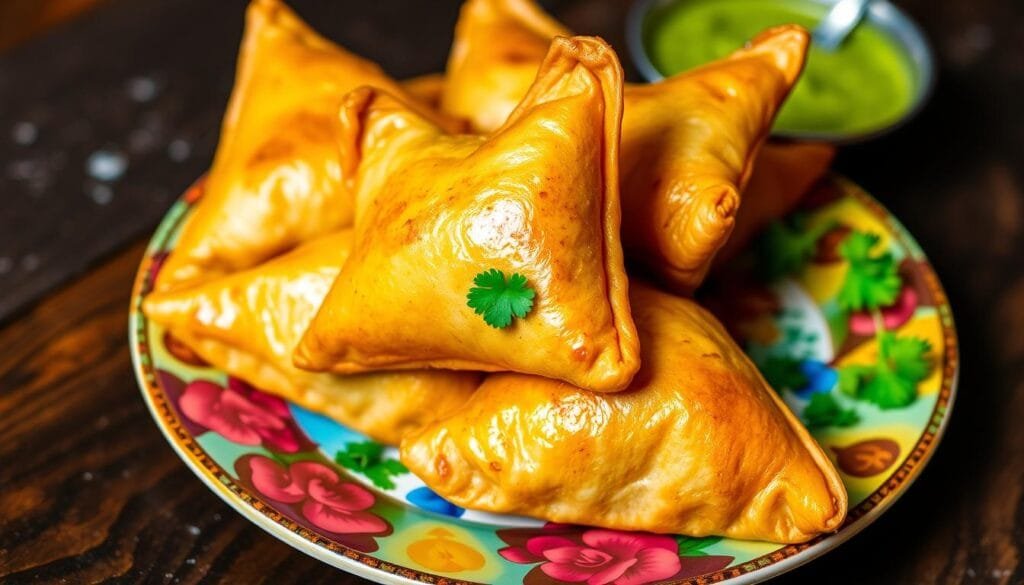
By following these tips for oil temperature and storage, your homemade crispy samosas will always be perfect. Enjoy your authentic Indian snack with confidence!
Serving Suggestions and Accompaniments
Samosas are a delightful Indian snack that pair beautifully with a variety of accompaniments. When serving these flavorful pastries, consider a selection of vibrant Indian chutneys. Options like mint chutney, tamarind chutney, or mango chutney are great. These samosa dipping sauces add a burst of freshness and acidity to balance the savory filling.
For a cooling contrast, a creamy yogurt-based dip or a sweet chili sauce can be a refreshing addition. Samosas are often enjoyed as a snack with a fragrant cup of masala chai, or as an appetizer before a larger Indian-inspired meal. They can be part of a diverse spread of vegan accompaniments and finger foods, making them a versatile choice for parties and gatherings.
| Accompaniment | Description |
|---|---|
| Mint Chutney | A vibrant, refreshing condiment made with fresh mint, cilantro, and spices. |
| Tamarind Chutney | A sweet and tangy chutney with a distinct sour flavor from tamarind pulp. |
| Mango Chutney | A sweet and slightly spicy condiment that adds a tropical twist to samosas. |
| Cucumber Raita | A cooling yogurt-based condiment with grated cucumber, mint, and spices. |
| Masala Chai | A aromatic and spiced Indian tea that complements the flavors of samosas. |
Whether you opt for traditional Indian accompaniments or explore more contemporary pairings, the versatility of samosas allows for endless serving possibilities. Experiment with different flavor profiles and textures to create a memorable dining experience.
Troubleshooting Common Samosa Problems
As a seasoned home cook, I know how frustrating it can be to make perfect samosas. Issues like soggy exteriors and leaky fillings are common. But don’t worry, I’ve got some tips to help your samosas be crispy, flavorful, and leak-proof every time.
Soggy samosas are a common problem. It’s often because the oil temperature is too low. Keep the oil at 130°C/265°F at first, then raise it to 180°C/350°F for a golden brown color. Also, make sure your samosas are sealed well to prevent filling leaks.
Uneven browning or darker sides on samosas can also happen. This usually means the oil temperature is changing too much. Keep an eye on the oil and adjust the heat to keep it steady. Also, turn and rotate the samosas while cooking to get an even, golden-brown finish.

